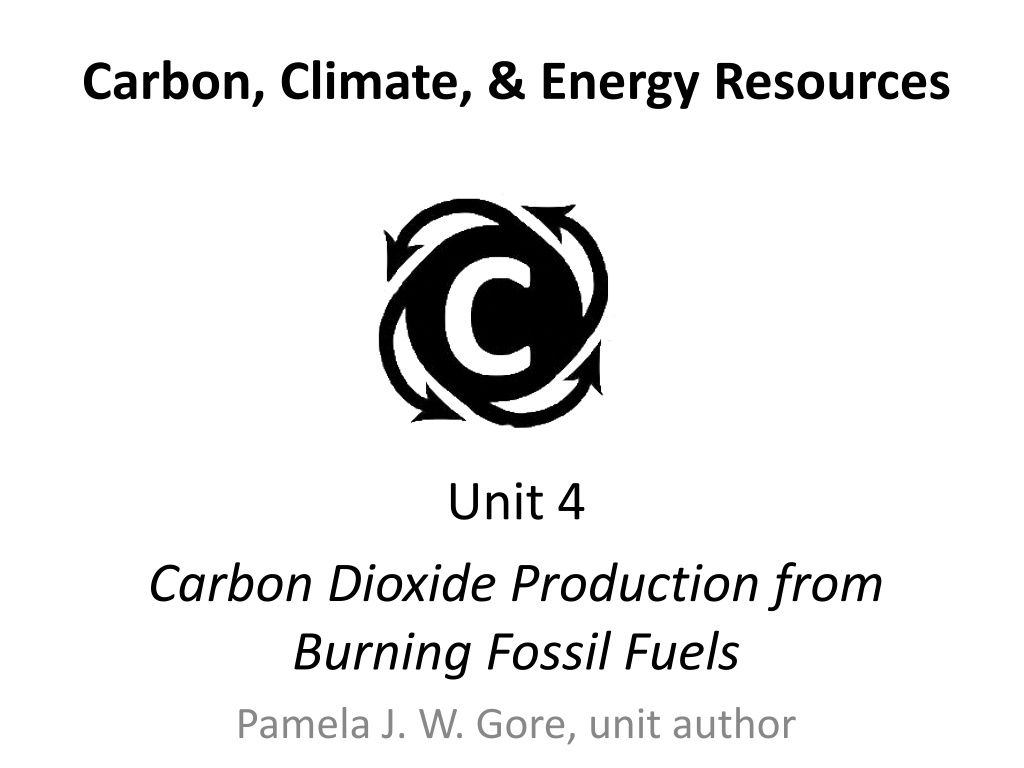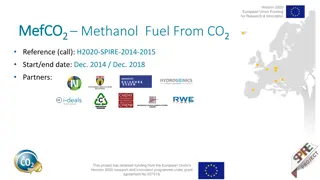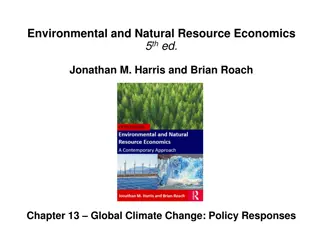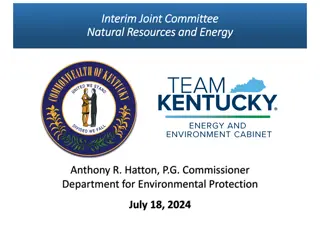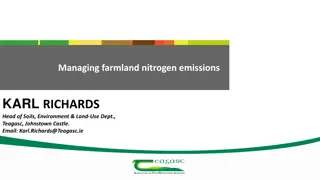Understanding Carbon Dioxide Emissions from Fossil Fuel Burning
Fossil fuel burning, particularly from coal and hydrocarbons, is a significant source of carbon dioxide (CO2) emissions, a greenhouse gas linked to global warming and climate change. This process results in the release of various byproducts into the atmosphere, including sulfur dioxide, nitrogen oxide, carbon monoxide, and toxic heavy metals. The weight of CO2 emissions varies across different fossil fuels, with natural gas (methane) being one of the highest emitters per million BTU of energy.
Download Presentation

Please find below an Image/Link to download the presentation.
The content on the website is provided AS IS for your information and personal use only. It may not be sold, licensed, or shared on other websites without obtaining consent from the author. Download presentation by click this link. If you encounter any issues during the download, it is possible that the publisher has removed the file from their server.
E N D
Presentation Transcript
Carbon, Climate, & Energy Resources Unit 4 Carbon Dioxide Production from Burning Fossil Fuels Pamela J. W. Gore, unit author
What happens when fossil fuels (like natural gas) burn? Carbon dioxide is produced CH4 (methane gas)+ 2O2 (gas) CO2(gas)+ 2H2O(liquid)+ Energy(joules) Burning fossil fuels is one of the largest sources of CO2, a greenhouse gas associated with global warming and climate change.
U.S. Greenhouse Gas Emissions (2012) Fluorinated gases, CFCs, 3% Nitrous oxide, 6% Methane, 9% Carbon dioxide, 82% Total Emissions in 2012 = 6,526 Million Metric Tons of CO2 equivalent
U.S. Greenhouse Gas Emissions (by Economic Sector) Agriculture 10% Commercial and Residential 10% Electricity generation 32% Industry 20% Transportation 28% Greenhouse gases are associated with global warming and climate change.
Sources of Carbon Dioxide The major sources of CO2 emissions are electricity generation and transportation. Coal is the major fossil fuel used to generate electricity in the United States. The major use of coal is electricity generation. There are about 560 coal-fired power plants in the United States. Worldwide about 50,000 power plants produce CO2. Burning coal and hydrocarbons are the largest sources of CO2 emissions.
Byproducts of Coal Burning Carbon and other elements combine with oxygen and are moved from the geosphere to the atmosphere. Carbon dioxide (a greenhouse gas, causes global warming). Sulfur dioxide (causes acid rain). Nitrogen oxide (causes smog). Carbon monoxide (poisonous gas, contributes to global warming). Small particles of toxic heavy metals.
Weight of CO2 (pounds) emitted per million BTU of energy Fossil fuel Lignite Sub-bituminous coal Bituminous coal Anthracite coal Diesel fuel and heating oil Gasoline Propane Natural gas (methane) 215.4 lb 214.3 lb 205.7 lb 228.6 lb Which fossil fuels have the highest CO2 emissions? 161.3 157.2 139.0 117.0
Weight of CO2 (pounds) emitted per million BTU of energy Fossil fuel Lignite Sub-bituminous coal Bituminous coal Anthracite coal Diesel fuel and heating oil Gasoline Propane Natural gas (methane) 215.4 lb 214.3 lb 205.7 lb 228.6 lb Which fossil fuels have the lowest CO2 emissions? 161.3 157.2 139.0 117.0
U.S. Energy Use and CO2 Emissions Burning petroleum products (gasoline, etc.) is the largest contributor to CO2 emissions
Energy Use and Carbon Dioxide Emissions in the United States Carbon dioxide emissions (%) 42% 27% 32% Fossil fuel Energy used (%) Petroleum Natural Gas Coal 35% 28% 18% Which fossil fuel produces the highest percentage of CO2 emissions? Which fossil fuel produces the lowest percentage of CO2 emissions?
The use of coal has decreased in the United States since 2008 Why? New environmental regulations make it more costly to operate some coal plants. Some electric power producers have switched to more competitively priced natural gas. Slow growth in electricity demand. Increased use of renewable energy technologies.
Why dont we use more natural gas for electricity generation, since it has lower CO2 emissions? In the past, the cost of natural gas was higher than coal. In recent years the price of natural gas has dropped. As a result, there has been a surge in natural gas production from U.S. shale deposits by fracking.
Sources of U.S. electricity generation What are some alternatives to fossil fuels?
Review Questions 1. What is the primary greenhouse gas emitted in the United States through human activities? 2. What are the major sources of CO2 emitted in the United States, by economic sector ? 3. What are the major byproducts of the burning of coal? 4. Which fossil fuel has the highest CO2 emissions? 5. Which fossil fuel has the lowest CO2 emissions?
Review Questions 5. Which fossil fuels are the major sources of electricity generation? 6. Why has coal use declined in recent years? 7. Which fossil fuel is the largest contributor to CO2 emissions? 8. What could we do to reduce CO2 emissions?
